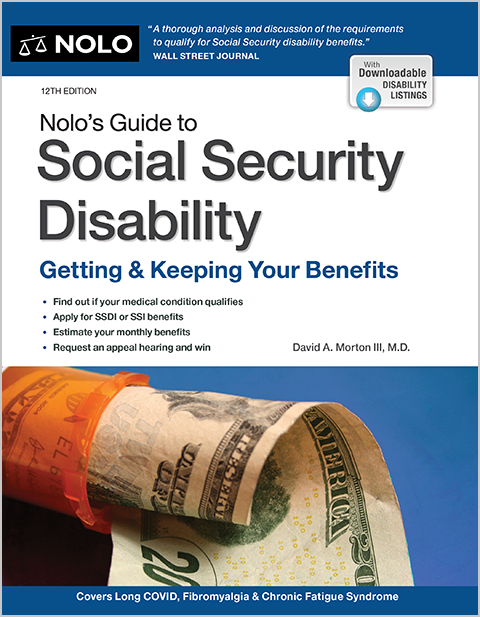In the past, receiving a pension reduced Social Security benefits. Learn about how the Windfall Elimination Provision and the Government Pension Offset worked.
Update: In December 2024, Congress eliminated the Windfall Elimination Provision and the Government Pension Offset described below. Government employees and their spouses will no longer receive a reduction in Social Security retirement, dependents, or survivors benefits due to the offsets. The law that ended these offsets is called the Social Security Fairness Act of 2023.
In the past, you could lose part of your Social Security retirement or disability benefits (SSDI) if you received an employee pension. That was true for certain types of pensions. (If you worked only for private employers and paid Social Security taxes (FICA) at each job, you were always able to keep your full pension and full Social Security benefits. Only if you worked in the private sector and for the government or another employer who didn't pay Social Security taxes would you see a reduction in Social Security.)
Now, receiving a government pension will not reduce your Social Security benefits. Here's how the Windfall Elimination Provision and the Government Pension Offset worked.
Which Pension Types Affected Social Security Benefits?
The 1983 Windfall Elimination Provision (WEP) required the Social Security Administration (SSA) to reduce your benefits if you had a pension from any employer that didn't withhold FICA taxes or pay into the Social Security system, such as:
- the U.S. government's civil service
- a state or local government, or
- a foreign employer.
If your pension came from a job where you paid FICA taxes or self-employment taxes, the WEP didn't change your Social Security benefits.
Why Did Having a Government Pension Affect Social Security?
First, some background. Social Security calculates benefits so that low-wage workers receive a higher percentage of their lifetime earnings than high-wage workers. High-wage earners still get more benefits, but it's a smaller portion of the wages they received when working.
Your Social Security disability or retirement benefits are based on your average monthly earnings over your lifetime (35 years). The SSA determines your benefit by dividing your average monthly earnings into three "bend points" (which change every year based on average wages). The agency then multiplies each bend point by a percentage (90%, 32%, and 15%) and then adds up the amounts to get your primary insurance amount (PIA). Your PIA is the amount of benefits you're entitled to receive. (Learn more about how Social Security determines how much your benefits will be.)
For someone who becomes eligible for benefits in 2024, the bend point calculations would be:
- 90% of the first $1,226
- 32% of earnings between $1,226 and $7,391, and
- 15% of earnings over $7,391.
Before the WEP, this resulted in people with full-time government jobs and relatively little private sector work receiving higher Social Security benefits because they were calculated as if they were long-term low-wage workers. So they could get a full government pension and Social Security benefits equal to 90% of their private sector earnings.
In 1983, the WEP changed that by requiring Social Security benefits to be offset based on pension amounts.
How Much Did the WEP Offset Reduce Social Security?
The formula that Congress used to calculate how big a bite will be taken out of your Social Security benefit due to the WEP was complicated. Basically, Social Security reduced the 90% multiple for the first bend point based in part on when you reached age 62 or became disabled. If it was in 1990 or later, the 90% factor could be reduced to as little as 40%.
Is There a Pension Offset for Spousal Benefits?
There is no longer a reduction in Social Security benefits for spouses who receive a government pension.
Under a separate law, also eliminated in 2024, a government pension would reduce any spouses, widows, or widowers benefits you could receive from Social Security. The Government Pension Offset (GPO) rule reduced Social Security spousal or survivor benefits by two-thirds of the amount of the government pension.
There was no reduction to your Social Security benefits if the government pension you were getting wasn't based on your own earnings (for instance, if you inherited it from your late spouse).
For more information, see Social Security's brochure on the Government Pension Offset.
Exceptions: When the WEP Offset Didn't Apply
The WEP rules didn't apply if your only government work was under the Federal Employees' Retirement System (FERS) or a similar program where you paid Social Security taxes on your income. But the WEP offset applied to any pension you earned as an employee of the federal government after 1956 under the Civil Service Retirement System (CSRS).
A WEP reduction of your Social Security benefits also didn't apply in the following situations:
- You were first hired as a federal worker after December 31, 1983.
- You were an employee of a non-profit organization that was exempt from Social Security coverage on December 31, 1983 (in most cases).
- Your only pension was for railroad employment.
- The only work you did without paying Social Security taxes was before 1957.
The WEP offset rules also changed if you worked for a number of years at jobs paying Social Security taxes.
If You Paid Social Security Taxes for 30 Years or More
Social Security wouldn't reduce your retirement benefits if you had 30 or more years of "substantial earnings" on which you paid Social Security taxes. What qualifies as substantial earnings changes each year, but for 2024, it's $31,275. (See the table below.)
|
Year |
Substantial Earnings |
Year |
Substantial Earnings |
Year |
Substantial Earnings |
|
1937–1954 |
$900 |
1986 |
$7,875 |
2005 |
$16,725 |
|
1955-1958 |
$1,050 |
1987 |
$8,175 |
2006 |
$17,475 |
|
1959-1965 |
$1,200 |
1988 |
$8,400 |
2007 |
$18,150 |
|
1966-1967 |
$1,650 |
1989 |
$8,925 |
2008 |
$18,975 |
|
1968-1971 |
$1,950 |
1990 |
$9,525 |
2009-2010 |
$19,800 |
|
1972 |
$2,250 |
1991 |
$9,900 |
2011 | $19,800 |
|
1973 |
$2,700 |
1992 |
$10,350 |
2012 |
$20,475 |
|
1974 |
$3,300 |
1993 |
$10,725 |
2013 |
$21,075 |
|
1975 |
$3,525 |
1994 |
$11,250 |
2014 |
$21,750 |
|
1976 |
$3,825 |
1995 |
$11,325 |
2015 |
$22,050 |
|
1977 |
$4,125 |
1996 |
$11,625 |
2016 |
$22,050 |
|
1978 |
$4,425 |
1997 |
$12,150 |
2017 |
$23,625 |
|
1979 |
$4,725 |
1998 |
$12,675 |
2018 |
$23,850 |
|
1980 |
$5,100 |
1999 |
$13,425 |
2019 |
$24,675 |
|
1981 |
$5,550 |
2000 |
$14,175 |
2020 |
$25,575 |
|
1982 |
$6,075 |
2001 |
$14,925 |
2021 |
$26,550 |
|
1983 |
$6,675 |
2002 |
$15,750 |
2022 |
$27,300 |
|
1984 |
$7,050 |
2003 |
$16,125 |
2023 |
$29,700 |
|
1985 |
$7,425 |
2004 |
$16,275 |
2024 |
$31,275 |
If You Paid Social Security Taxes for 20-30 Years
If you had 20 or fewer years of substantial earnings, you would still get hit by the offset.
The good news is that if you had 21 years of substantial earnings or more (but fewer than 30), your benefits would still be reduced, but the percentage used to calculate your monthly benefit was reduced progressively. So, at 30 years or more of substantial earnings, the percentage of your first bend point taken was 90%, but for less than 30 years, it dropped 5% for each year less than 30, as follows:
|
Number of Years |
Percentage |
|
29 years |
85% |
|
28 years |
80% |
|
27 years |
75% |
|
26 years |
70% |
|
25 years |
65% |
|
24 years |
60% |
|
23 years |
55% |
|
22 years |
50% |
|
21 years |
45% |
|
20 years or less |
40% |
Also, if your Social Security benefits were reduced due to WEP (or GPO), the offset wouldn't affect your eligibility for Medicare. You could still get Medicare based on your spouse's work record, even if your government pension makes you ineligible to receive any Social Security benefits.


